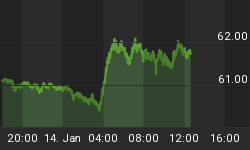If you were paying attention, you would have noticed that this past week's sentiment update did not contain the "Smart Money" indicator. This wasn't an oversight on my part but a purposeful omission. With NYSE data difficult to obtain, the "smart money" is now solely constructed from the S&P100 Options (i.e., the OEX put call ratio). S&P100 options are thought to represent the large money trader. As it is constructed now (i.e., only SP100 put call data), this indicator has had little value since the 2000 bull market top. In essence, the "smart money" isn't so smart, and we find that this is just a good bull market indicator.
The "smart money" indicator is shown in figure 1, a weekly chart of the S&P500. When the indicator is green, these "smart money" traders are bullish on the markets, and being that this is suppose to be the "smart money" we would want to follow their lead. But is this true? To get the answers let's look at some data.
Figure 1. Smart Money/ weekly
Let's construct a study where we buy the S&P500 and hold our position only during those times the indicator is green or only when the "smart money" indicator is bullish. Such a strategy produces the following equity curve (figure 2). The study starts in 1985 and encompasses 187 unique occurrences or trades. While not a great strategy from 1985 to 2000, this strategy has definitely been on a down slope since the 2000 bull market top.
Figure 2. Equity Curve
In the second study, we buy the S&P500 when the "smart money" indicator is bullish and we sell our position 4 weeks later. Once again, the strategy begins in 1985 and this strategy generated 155 trades. As we can see from the equity curve in figure 3, the bull market, 2000 top is easily identified. From 1985 to 2000, this was a very good strategy; since 2000, this wasn't so good.
Figure 3. Equity Curve
Well maybe our holding period isn't long enough. After all the "smart money" or "big money" may position itself for the big picture, long term market moves. So let's increase our holding period to an intermediate term period of 13 weeks. So in this strategy, we buy the S&P500 when the "smart money" is bullish or when the indicator first turns green and we sell that position 13 weeks later. This generates the equity curve in figure 4.
Figure 4. Equity Curve
While the longer holding period produces positive returns, the pattern of the equity curve is familiar. This is a great bull market strategy, but since 2000, this has been a losing strategy.
In sum, calling the S&P100 put call data the "smart money" is a misnomer. The "smart money" performs best under bull market conditions. During bear markets, the "smart money" isn't so smart. (I could argue that wasn't so smart under bull market conditions either, but we will leave that argument for another day.) In the final analysis, it is hard to see how this data is helpful or will lead to market beating returns.
















